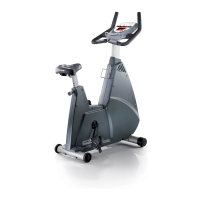12
GUIDELINES
Varied training in all three of these zones will add to increased levels of fitness and improved performance
and add more energy to your life. "Most training programs use a combination of training intensities to increase
performance capacity," according to J. T. Kearney, Ph.D., Senior Exercise Physiologist at the U. S. Olympic Training
Center in Colorado Springs. Kearney suggests that it is important for individuals to monitor intensity. "There are
many different ways to monitor training but monitoring heart rate response is the simplest, most convenient and
least expensive physiological method for monitoring training," Kearney says.
> Predicted Target Heart Rate Zones for Different Ages
Age Maximum Predicted Aerobic Target
Heart Rate Zone: 60-85 %
20 200 120-170
25 195 117-166
30 190 114-162
35 185 111-157
40 180 108-153
45 175 105-149
50 170 102-145
55 165 99-140
60 160 96-136
After several weeks of "aerobic conditioning," certain changes become apparent. What was a barely
attainable level of exercise before, now becomes quite easy. Whereas cycling or running at a certain pace
or speed may have previously caused your heart rate to go up to 135 beats per minute, that pace can now be
achieved at a lower heart rate. In short, your heart is becoming stronger, larger and more efficient, and your body
is able to do the same work with less stain.
Regardless of your maximum average heart rate or your target heart rate, you should consult with your phy-
sician or with a sports medical expert to establish, with precision, the rates that are right for you, your age and
your medical and physical condition. This is especially important if you are over the age of 35, been sedentary for
several years, overweight or have a history of heart disease in your family.
> Beating The Dropout Odds: Jump Start Your Fitness Program
You already know you need to exercise. And you're probably trying – at least a little. But let's get serious:
If you don't add regular exercise to your life, you're missing out on a sure bet. This is one area where medical
research all points in the same direction.
"Starting to exercise is comparable, from a health benefit standpoint, to quitting smoking," says the
recently released Surgeon's General Report on Physical Activity and Health.
> To sum up the recent report:
> Regular physical activity offers substantial improvements in health and well-being for the majority of Americans.
> If you exercise regularly, the reports show, you'll reduce your risk of heart attack, cancer, diabetes, high blood
pressure, osteoporosis, and even the common cold.
> Regular exercise, regardless of the intensity, can help you control stress, sleep problems, and depression. But
even with all this evidence, only 22 percent of Americans engage in exercise for 20 minutes a day. And even
among individuals who begin exercise programs, the dropout rate is about 50 percent.
TABLE 1 EXERCISE GUIDELINES

